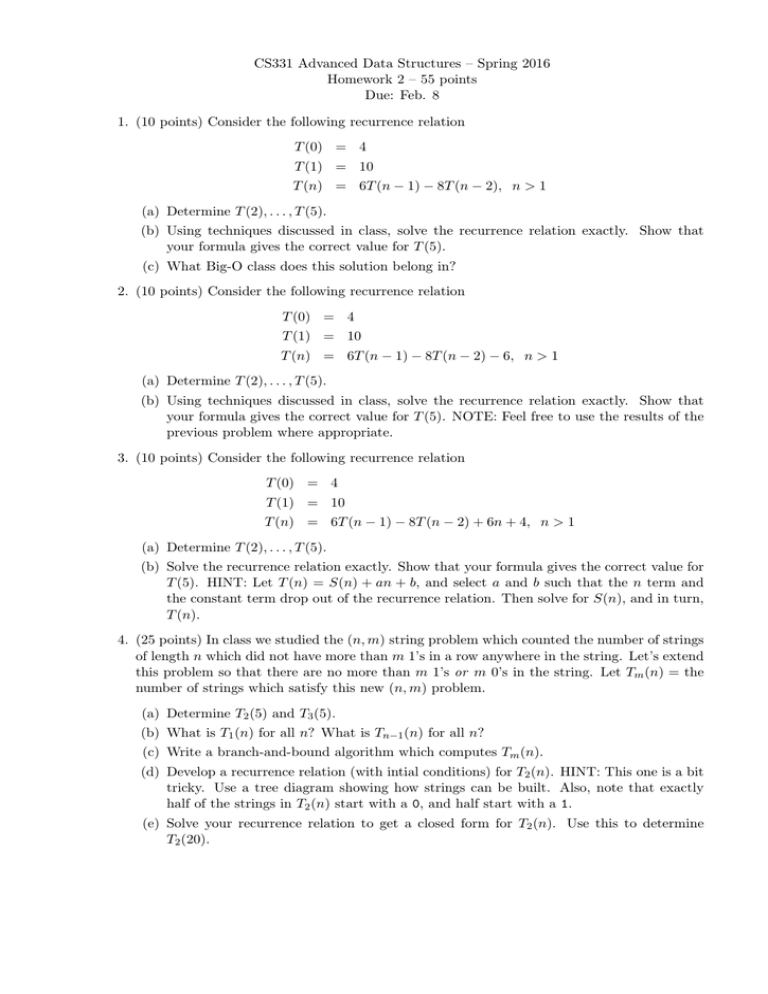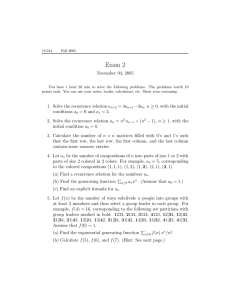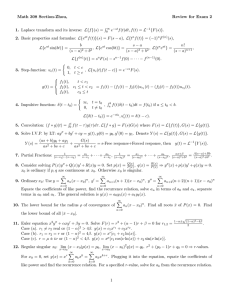CS331 Advanced Data Structures – Spring 2016 Due: Feb. 8
advertisement

CS331 Advanced Data Structures – Spring 2016 Homework 2 – 55 points Due: Feb. 8 1. (10 points) Consider the following recurrence relation T (0) = 4 T (1) = 10 T (n) = 6T (n − 1) − 8T (n − 2), n > 1 (a) Determine T (2), . . . , T (5). (b) Using techniques discussed in class, solve the recurrence relation exactly. Show that your formula gives the correct value for T (5). (c) What Big-O class does this solution belong in? 2. (10 points) Consider the following recurrence relation T (0) = 4 T (1) = 10 T (n) = 6T (n − 1) − 8T (n − 2) − 6, n > 1 (a) Determine T (2), . . . , T (5). (b) Using techniques discussed in class, solve the recurrence relation exactly. Show that your formula gives the correct value for T (5). NOTE: Feel free to use the results of the previous problem where appropriate. 3. (10 points) Consider the following recurrence relation T (0) = 4 T (1) = 10 T (n) = 6T (n − 1) − 8T (n − 2) + 6n + 4, n > 1 (a) Determine T (2), . . . , T (5). (b) Solve the recurrence relation exactly. Show that your formula gives the correct value for T (5). HINT: Let T (n) = S(n) + an + b, and select a and b such that the n term and the constant term drop out of the recurrence relation. Then solve for S(n), and in turn, T (n). 4. (25 points) In class we studied the (n, m) string problem which counted the number of strings of length n which did not have more than m 1’s in a row anywhere in the string. Let’s extend this problem so that there are no more than m 1’s or m 0’s in the string. Let Tm (n) = the number of strings which satisfy this new (n, m) problem. (a) Determine T2 (5) and T3 (5). (b) What is T1 (n) for all n? What is Tn−1 (n) for all n? (c) Write a branch-and-bound algorithm which computes Tm (n). (d) Develop a recurrence relation (with intial conditions) for T2 (n). HINT: This one is a bit tricky. Use a tree diagram showing how strings can be built. Also, note that exactly half of the strings in T2 (n) start with a 0, and half start with a 1. (e) Solve your recurrence relation to get a closed form for T2 (n). Use this to determine T2 (20).







